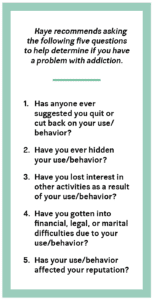Learn How to Recognize Addiction


Marriage and Family/Sex Therapist,
I Love Us Relationship & Intimacy Counseling
The term “addiction” often calls to mind drug users and gamblers. But addiction – a complex disease that affects millions of Americans – comes in many forms, from the gaming-obsessed teenager to the compulsive online shopper. “An addict can’t seem to stop their using or their behavior, and it eventually inhibits their freedom to choose,” says Karisa Kaye, local marriage and family/sex therapist. “An addiction becomes the most important thing in a person’s life.” Here, Kaye offers professional insight into recognizing and recovering from an addiction.
By Mary Beth Wallace
What constitutes an addiction?
“An addiction is a disorder of the brain’s reward system, which may manifest as a result of genetics or environmental factors,” Kaye says. “It’s characterized by an impaired control over substances or behavior, a preoccupation with substances or behavior, and continued use despite consequences.” According to Kaye, people can be addicted to almost anything – even perceivably healthy habits, like exercise and dieting. Caffeine, tobacco, alcohol, marijuana, painkillers, and cocaine are the most common substance addictions, while behaviorally, common addictions include gambling, anger, food, sex, pornography, the internet, and work.
What are the telltale signs of addiction?
Addiction causes harm to a person’s physical and mental health, and these negative effects are often perceptible to the observant eye. When trying to recognize an addiction, look for classic signs such as changes in personality (irresponsibility, lying, isolation, mood swings) and changes in appearance (weight loss or gain, unexplained injuries, bloodshot eyes, bad skin or teeth). More long-term consequences can include financial trouble, damaged relationships, arrests, or the loss of a job. Kaye says, “A person’s work life and personal life will begin to noticeably suffer as a result of addiction, as an addiction may become the main focus of someone’s daily pursuit, even if it means neglecting other life responsibilities.” If left untreated, an addiction becomes more disabling – and potentially life-threatening – over time.
After identifying an addiction, what are the next steps?
Depending on the type and level of addiction, there are several different ways to move forward – but the first step has to be honesty. Kaye shares, “It takes a lot of courage to look at your life and acknowledge you’re trapped. The first step of any recovery program is going to encourage honesty, which is admitting ‘Hi, I’m so and so, and I struggle with [blank].’” Once you’ve been honest with yourself and others, it’s time to reach out for professional help.
Treatment will vary from case to case, so it’s important to create a plan customized to your unique situation. Visiting a therapist or health care professional can help determine the best path, whether that includes weekly behavioral counseling or a stay in an inpatient rehabilitation facility. Either way, Kaye emphasizes recovery takes hard work – and it’s more than simply ceasing the behavior or the use of a substance. “You need to figure out why you were using, who you hurt in the process, how to make amends to those people, and what steps you’ll take to make new choices and a new life for yourself.”
Reaching out for support is also a crucial step in the recovery process. “Recovery cannot be done in isolation – we need others around us to help us get better,” Kaye says. “Part of recovery is community and accountability and relationship.” Leaning on family, joining a local support group, and building a strong social network of positive influences can provide encouragement and guidance for the road ahead.


